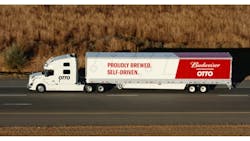Truck, Taxi, Delivery Driver Jobs Will be Automated Says US Government
The White House said this week that nearly 3.1 million drivers working today could have their jobs automated by autonomous vehicles.
However, as reported by Dave Gershgorm of Quartz, the government didn’t specify when this automation could occur.
Heavy trucking will take a hit with 80% to 100% of nearly 1.7 million drivers’ jobs automated. Delivery drivers and self-employed drivers for on-demand services like Uber will face almost total automation as well.
The report titled “Artificial Intelligence, Automation and the Economy” said that ”economic incentives and public policy can play a significant role in shaping the direction and effects of technological change. Given appropriate attention and the right policy and institutional responses, advanced automation can be compatible with productivity, high levels of employment, and more broadly shared prosperity.”
This report advocates strategies to educate and prepare new workers to enter the workforce, cushion workers who lose jobs, keep them attached to the labor force, and combat inequality. Most of these strategies would be important regardless of AI-driven automation, but all take on even greater importance to the degree that AI is making major changes to the economy.
The White House suggested the following strategies:
Strategy #1: Invest in and develop AI for its many benefits. If care is taken to responsibly maximize its development, AI will make important, positive contributions to aggregate productivity growth, and advances in AI technology hold incredible potential to help the United States stay on the cutting edge of innovation. Government has an important role to play in advancing the AI field by investing in research and development.
Among the areas for advancement in AI are cyberdefense and the detection of fraudulent transactions and messages. In addition, the rapid growth of AI has also dramatically increased the need for people with relevant skills from all backgrounds to support and advance the field. Prioritizing diversity and inclusion in STEM fields and in the AI community specifically, in addition to other possible policy responses, is a key part in addressing potential barriers stemming from algorithmic bias.
Competition from new and existing firms, and the development of sound pro-competition policies, will increasingly play an important role in the creation and adoption of new technologies and innovations related to AI.
Strategy #2: Educate and train Americans for jobs of the future. As AI changes the nature of work and the skills demanded by the labor market, American workers will need to be prepared with the education and training that can help them continue to succeed. Delivering this education and training will require significant investments. This starts with providing all children with access to high-quality early education so that all families can prepare their students for continued education, as well as investing in graduating all students from high school college- and careerready, and ensuring that all Americans have access to affordable post-secondary education.
Assisting U.S. workers in successfully navigating job transitions will also become increasingly important; this includes expanding the availability of job-driven training and opportunities for lifelong learning, as well as providing workers with improved guidance to navigate job transitions.
Strategy #3: Aid workers in the transition and empower workers to ensure broadly shared growth. Policymakers should ensure that workers and job seekers are both able to pursue the job opportunities for which they are best qualified and best positioned to ensure they receive an appropriate return for their work in the form of rising wages.
This includes steps to modernize the social safety net, including exploring strengthening critical supports such as unemployment insurance, Medicaid, Supplemental Nutrition Assistance Program (SNAP), and Temporary Assistance for Needy Families (TANF), and putting in place new programs such as wage insurance and emergency aid for families in crisis. Worker empowerment also includes bolstering critical safeguards for workers and families in need, building a 21st century retirement system, and expanding healthcare access. Increasing wages, competition, and worker bargaining power, as well as modernizing tax policy and pursuing strategies to address differential geographic impact, will be important aspects of supporting workers and addressing concerns related to displacement amid shifts in the labor market.
The report concludes that “ if a significant proportion of Americans are affected in the short- and medium-term by AI-driven job displacements, policymakers will need to consider more robust interventions, such as further strengthening the unemployment insurance system and countervailing job creation strategies, to smooth the transition.”
